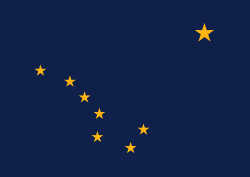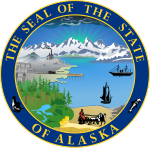
Back Alaska Afrikaans Alaska ALS አላስካ Amharic Alaska AN Ēalascæ ANG ألاسكا Arabic ܐܠܐܣܟܐ ARC ألاسكا ARY الاسكا ARZ Alaska AST
Alaska
| |
|---|---|
| Nickname: The Last Frontier | |
| Motto: North to the Future | |
| Anthem: Alaska's Flag | |
 Location of Alaska within the United States | |
| Country | United States |
| Before statehood | Territory of Alaska |
| Admitted to the Union | January 3, 1959 (49th) |
| Capital | Juneau |
| Largest city | Anchorage |
| Largest metro and urban areas | Anchorage |
| Government | |
| • Governor | Mike Dunleavy (R) |
| • Lieutenant Governor | Nancy Dahlstrom (R) |
| Legislature | Alaska State Legislature |
| • Upper house | State Senate |
| • Lower house | House of Representatives |
| Judiciary | Alaska Supreme Court |
| U.S. senators |
|
| U.S. House delegation | Nick Begich III (R) (list) |
| Area | |
• Total | 665,384[1] sq mi (1,723,337 km2) |
| • Land | 586,412 square miles[2] sq mi (1,518,800 km2) |
| • Water | 91,316 sq mi (236,507 km2) 13.77% |
| • Rank | 1st |
| Dimensions | |
| • Length | 1,420 mi (2,285 km) |
| • Width | 2,261 mi (3,639 km) |
| Elevation | 1,900 ft (580 m) |
| Highest elevation | 20,310 ft (6,190.5 m) |
| Lowest elevation | 0 ft (0 m) |
| Population (2024) | |
• Total | |
| • Rank | 48th |
| • Density | 1.10/sq mi (0.42/km2) |
| • Rank | 50th |
| • Median household income | $86,600 (2023)[5] |
| • Income rank | 12th |
| Demonym | Alaskan |
| Language | |
| • Official languages | Ahtna, Alutiiq, Dena'ina, Cup'ig, Deg Xinag, English, Eyak, Gwich'in, Haida, Hän, Holikachuk, Inupiaq, Koyukon, Lower Tanana, Middle Tanana, St. Lawrence Island Yupik, Tanacross, Tlingit, Tsimshian, Unangax̂, Upper Kuskokwim, Upper Tanana, Yup'ik, Wetał |
| • Spoken language |
|
| Time zones | |
| east of 169°30' | UTC−09:00 (AKST) |
| • Summer (DST) | UTC−08:00 (AKDT) |
| west of 169°30' | UTC−10:00 (HST) |
| • Summer (DST) | UTC−09:00 (HDT) |
| USPS abbreviation | AK |
| ISO 3166 code | US-AK |
| Latitude | 51°20'N to 71°50'N |
| Longitude | 130°W to 172°E |
| Website | alaska |
| List of state symbols | |
|---|---|
 | |
 | |
| Living insignia | |
| Bird | Willow ptarmigan |
| Dog breed | Alaskan Malamute |
| Fish | King salmon |
| Flower | Forget-me-not |
| Insect | Four-spot skimmer dragonfly |
| Mammal |
|
| Tree | Sitka Spruce |
| Inanimate insignia | |
| Fossil | Woolly Mammoth |
| Gemstone | Jade |
| Mineral | Gold |
| Sport | Dog mushing |
| State route marker | |
 | |
| State quarter | |
 Released in 2008 | |
Alaska (/əˈlæskə/ ⓘ ə-LASS-kə) is a non-contiguous U.S. state on the northwest extremity of North America. Part of the Western United States region, it is one of the two non-contiguous U.S. states, alongside Hawaii. Alaska is also considered to be the northernmost, westernmost, and easternmost (the Aleutian Islands cross the 180th meridian into the eastern hemisphere) state in the United States. It borders the Canadian territory of Yukon and the province of British Columbia to the east. It shares a western maritime border, in the Bering Strait, with Russia's Chukotka Autonomous Okrug. The Chukchi and Beaufort Seas of the Arctic Ocean lie to the north, and the Pacific Ocean lies to the south. Technically, it is a semi-exclave of the U.S., and is the largest exclave in the world.
Alaska is the largest U.S. state by area, comprising more total area than the following three largest states of Texas, California, and Montana combined, and is the seventh-largest subnational division in the world. It is the third-least populous and most sparsely populated U.S. state; however, with a population of 740,133 as of 2024, it is the most populous territory in North America located mostly north of the 60th parallel, with more than quadruple the combined populations of Northern Canada and Greenland.[6] The state contains the four largest cities in the United States by area, including the state capital of Juneau. The state's most populous city is Anchorage, and approximately half of Alaska's residents live within its metropolitan area.
Indigenous people have lived in Alaska for thousands of years, and it is widely believed that the region served as the entry point for the initial settlement of North America by way of the Bering land bridge. The Russian Empire was the first to actively colonize the area beginning in the 18th century, eventually establishing Russian America, which spanned most of the current state and promoted and maintained a native Alaskan Creole population.[7] The expense and logistical difficulty of maintaining this distant possession prompted its sale to the U.S. in 1867 for US$7.2 million (equivalent to $157 million in 2023). The area went through several administrative changes before becoming organized as a territory on May 11, 1912. It was admitted as the 49th state of the U.S. on January 3, 1959.[8]
Abundant natural resources have enabled Alaska— with one of the smallest state economies—to have one of the highest per capita incomes, with commercial fishing, and the extraction of natural gas and oil, dominating Alaska's economy. U.S. Armed Forces bases and tourism also contribute to the economy; more than half of the state is federally-owned land containing national forests, national parks, and wildlife refuges. It is among the most irreligious states and one of the first to legalize recreational marijuana. The Indigenous population of Alaska is proportionally the second highest of any U.S. state, at over 15 percent, after only Hawaii.[9]
- ^ "State Area Measurements and Internal Point Coordinates". Census.gov. Archived from the original on April 7, 2020. Retrieved September 1, 2023.
- ^ "Geography of Alaska, Alaska Kids' Corner, State of Alaska". Archived from the original on December 3, 2023. Retrieved January 17, 2024.
- ^ "Elevations and Distances in the United States". United States Geological Survey. 2001. Archived from the original on October 15, 2011. Retrieved October 21, 2011.
- ^ "United States Census Quick Facts Alaska". Retrieved January 9, 2025.
- ^ "Household Income in States and Metropolitan Areas: 2023" (PDF). Retrieved January 12, 2025.
- ^ "2020 Census Apportionment Results". census.gov. United States Census Bureau. Archived from the original on April 26, 2021. Retrieved April 30, 2021.
- ^ Black, Lydia (2004). Russians in Alaska, 1732-1867. University of Alaska Press. pp. 217, 218.
- ^ Video: 49th Star. Alaska Statehood, New Flag, Official, 1959/01/05 (1959). Universal Newsreel. 1959. Archived from the original on May 15, 2012. Retrieved February 20, 2012.
- ^ "U.S. Census Bureau QuickFacts: Alaska". census.gov. Archived from the original on December 29, 2018. Retrieved February 17, 2020.


